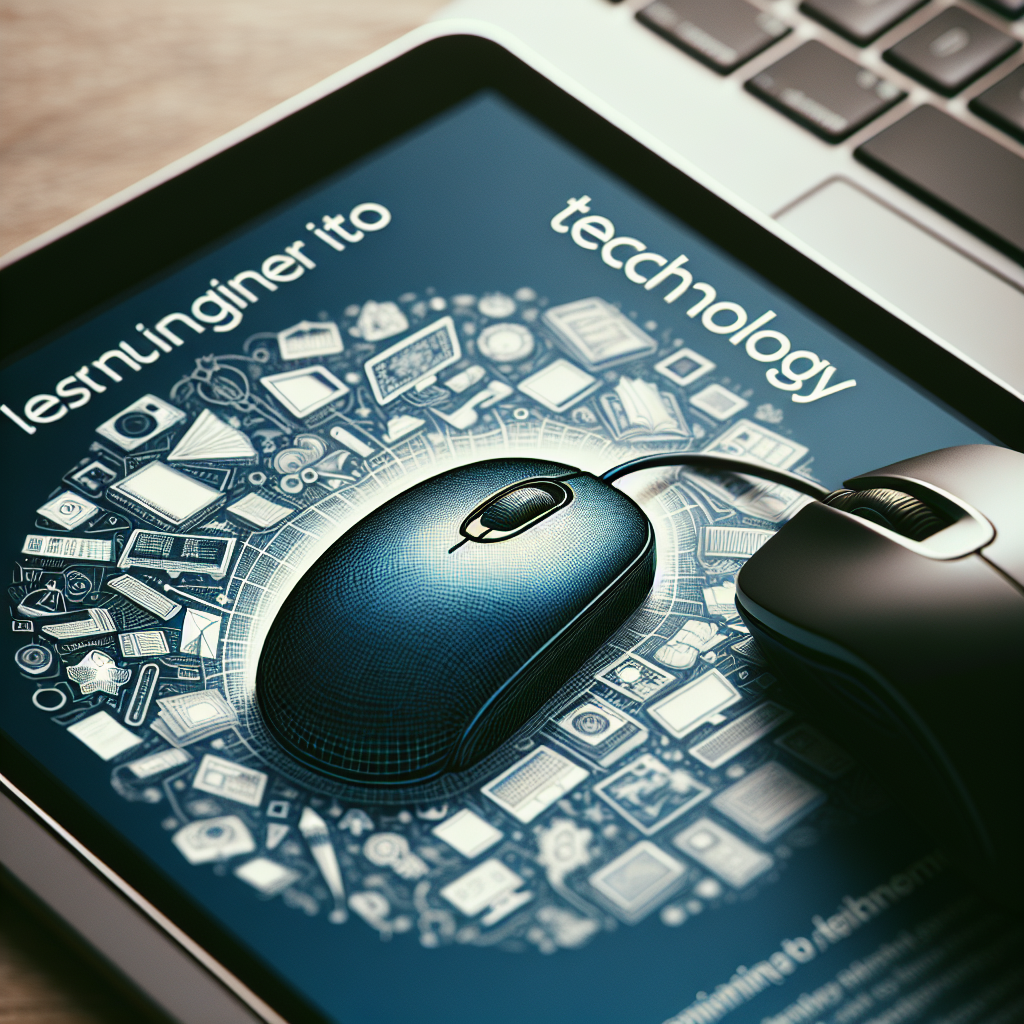In this comprehensive guide, you will find a plethora of useful tech tips and tricks to help beginners navigate the world of technology with ease. From basic troubleshooting to maximizing the potential of your devices, this article is packed with insightful information that will empower you to embrace the digital world with confidence. Whether you are new to smartphones, computers, or other gadgets, this guide will provide you with the knowledge and tools necessary to navigate any technological challenge that may come your way. Get ready to unlock your tech-savviness and embark on a journey of discovery and productivity!
Computer Basics
Welcome to the world of computers! Whether you’re a complete beginner or someone looking to refresh their knowledge, understanding the basics of hardware and software is essential.
Understanding Hardware and Software
When it comes to computers, you’ll often hear the terms “hardware” and “software.” Hardware refers to the physical components of a computer system, such as the central processing unit (CPU), memory (RAM), hard drive, and input/output devices like the keyboard and mouse. Software, on the other hand, includes the programs and instructions that tell the hardware how to perform specific tasks.
To better understand this relationship, think of the hardware as the body of the computer, and the software as its brain. Without the hardware, software cannot function, and without software, hardware is just a collection of inert parts.
Navigating the Desktop
Once you turn on your computer, you’ll find yourself on the desktop, which is the main screen where you can access various features and programs. The desktop typically includes icons representing files, folders, and applications. You can double-click on an icon to open a file or launch an application.
By right-clicking on the desktop, you can access a context menu that allows you to personalize your desktop by changing background wallpapers and screen resolutions. It’s also where you can create new folders or shortcuts for frequently used programs.
Managing Files and Folders
Files and folders are fundamental aspects of organizing your computer’s data. A file is a collection of data, such as a document or a photo, while a folder is a container used to hold files. By organizing your files into folders, you can keep everything neat and easily accessible.
To create a new folder, right-click on the desktop or inside an existing folder, select “New,” and then “Folder.” You can then name the folder and begin organizing your files within it. To move files into a folder, simply drag and drop them into the desired location.
It’s important to maintain a well-organized file and folder structure on your computer, as it will make it much easier to find specific files when you need them. Take some time to familiarize yourself with how to create, rename, move, and delete files and folders.
Internet Essentials
In today’s connected world, the internet has become an integral part of our lives. Understanding how to connect to Wi-Fi, browse the web, and use search engines are essential skills for navigating the online realm.
Connecting to Wi-Fi
To access the internet wirelessly, you’ll need to connect to a Wi-Fi network. Most devices, such as laptops, smartphones, and tablets, have built-in Wi-Fi capabilities. In the settings menu, locate the Wi-Fi option and turn it on. Your device will then scan for available networks, and you can select the network you want to connect to. If the network requires a password, enter it when prompted.
Browsing the Web
Once connected to the internet, you can launch a web browser to start browsing the web. Popular web browsers include Google Chrome, Mozilla Firefox, and Microsoft Edge. To navigate to a website, simply type its address into the address bar and press Enter. Websites can contain a wealth of information, ranging from news articles and educational resources to entertainment and social media platforms.
Using Search Engines
Search engines serve as your gateway to the vast amounts of information available on the internet. You can use search engines like Google, Bing, or Yahoo by typing your query into the search bar and clicking the “Search” button. The search engine will then display a list of results related to your query. To refine your search, you can use specific keywords or use advanced search operators.
Remember to be cautious when clicking on search results, as not all websites are trustworthy. It’s always a good idea to verify the credibility of a website before providing personal information or downloading files.
This image is property of images.unsplash.com.
Email has revolutionized communication, allowing you to send and receive messages instantly across the globe. Understanding how to create and manage an email account, as well as compose and send emails, is essential in today’s digital world.
Creating an Email Account
To create an email account, you’ll need to choose an email service provider such as Gmail, Outlook, or Yahoo Mail. Visit the provider’s website and look for a “Sign Up” or “Create Account” option. Follow the prompts to create a unique username and password for your email account. Be sure to choose a strong password that includes a combination of letters, numbers, and special characters to protect your account from unauthorized access.
Writing and Sending Emails
Once you have an email account set up, you can start composing and sending emails. To begin, click on the “Compose” or “New Email” button, which will open a new email window. Enter the recipient’s email address in the “To” field, add a relevant subject line, and then type your message in the body of the email. You can also format the text, add attachments, and include hyperlinks if needed. When you’re ready, click “Send” to deliver your message.
Managing Inbox and Contacts
As you start receiving emails, it’s important to stay organized. Create folders within your email account to categorize and store important messages. You can also use email filters to automatically sort incoming emails based on specific criteria.
Managing contacts is also crucial for efficient communication. Most email services allow you to create a contact list, making it easier to send emails to frequently contacted individuals. Take some time to explore your email provider’s features and make use of organizational tools to keep your inbox clutter-free.
Online Security
In an increasingly digital world, ensuring your online security is of paramount importance. By understanding how to create strong passwords, recognizing phishing attempts, and using antivirus software, you can protect yourself from potential threats.
Creating Strong Passwords
A strong password is your first line of defense against unauthorized access to your accounts. It’s crucial to create unique passwords for each online account you have and avoid using easily guessable information such as birthdays or names. Aim for a mix of uppercase and lowercase letters, numbers, and special characters. Consider using a password manager to help you generate and store complex passwords securely.
Understanding Phishing
Phishing is a deceptive technique used by cybercriminals to trick individuals into revealing sensitive information such as passwords or credit card details. They often masquerade as legitimate organizations through fraudulent emails, messages, or websites. Be cautious when clicking on links or providing personal information online. Look out for signs of phishing, such as misspellings, generic greetings, or urgent requests for personal information. When in doubt, directly contact the organization using their verified contact information to verify the authenticity.
Using Antivirus Software
Antivirus software is designed to detect, prevent, and remove malicious software, commonly known as malware, from your computer. It provides a crucial layer of protection by scanning files and monitoring online activities for any signs of potential threats. Install a reliable antivirus program on your computer, keep it up to date, and regularly scan your system for any potential risks. Be cautious when downloading files or clicking on links, as antivirus software can only do so much. Exercise good judgment and be vigilant about online security practices.
This image is property of images.unsplash.com.
Digital Privacy
Protecting your digital privacy is essential in today’s interconnected world. By understanding how to adjust privacy settings, clear browsing history, and use virtual private network (VPN) services, you can have greater control over your personal information.
Adjusting Privacy Settings
Many platforms and applications have privacy settings that allow you to control what information is shared and who can access it. Take the time to review and adjust these settings to suit your preferences. Limit the amount of personal information visible to others and be cautious about granting excessive permissions to apps or websites. Regularly check and update your privacy settings as new features and options may become available.
Clearing Browsing History
Web browsers keep a record of the websites you visit, which can potentially compromise your privacy. To protect your browsing history, regularly clear your browser’s cache and cookies. This will remove temporary files and stored data from your computer, making it harder for anyone to track your online activities. Most browsers have settings that allow you to manage your browsing history and provide options for clearing it selectively or completely.
Using VPN Services
A virtual private network (VPN) is a service that encrypts your internet connection and routes it through a remote server, providing you with an additional layer of privacy and security. VPNs are particularly useful when using public Wi-Fi networks or accessing geo-restricted content. Research reputable VPN providers and consider using one to protect your online activities, especially when handling sensitive information or accessing confidential resources.
Social Media
Social media platforms have become an integral part of how we communicate and connect with others. By understanding how to sign up for social media platforms, navigate their interfaces, and practice privacy and security tips, you can enjoy a safer and more enjoyable online experience.
Signing Up for Social Media Platforms
To join a social media platform, you’ll typically need to create a user account. Visit the platform’s website or download the app from your device’s app store. Follow the registration prompts, providing the required information such as your name, email address, and date of birth. Choose a unique username and password, and consider enabling two-factor authentication for added security.
Navigating the Interface
Each social media platform has its own unique interface and features. Take some time to explore and familiarize yourself with the platform’s layout, settings, and features. Most platforms allow you to customize your profile, post updates, share photos and videos, and interact with others through comments, likes, and direct messages. Adjust your privacy settings to control who can see your posts and personal information.
Privacy and Security Tips
When using social media, it’s important to be mindful of your privacy and security. Avoid sharing sensitive personal information publicly, such as your home address or phone number. Be cautious when accepting friend or connection requests from unfamiliar individuals. Regularly review and update your privacy settings to ensure you’re comfortable with the information that’s accessible to others. Remember that once something is shared on social media, it can spread quickly and may be difficult to completely remove.

This image is property of images.unsplash.com.
Mobile Devices
Mobile devices like smartphones and tablets have become an integral part of our daily lives. Understanding how to navigate your device, install and update apps, and manage battery life can enhance your mobile experience.
Understanding Your Smartphone or Tablet
Mobile devices have user-friendly interfaces designed for touch navigation. Explore the various features and functions of your device, such as making calls, sending messages, accessing the internet, and using apps. Familiarize yourself with the device’s settings menu, where you can customize various options such as display brightness, notification preferences, and security features.
Installing and Updating Apps
Apps add functionality and entertainment to your mobile device. To install new apps, visit your device’s app store, such as Google Play Store or Apple App Store, and search for the desired app. Tap on the app, then select “Install” or “Get” to download and install it on your device. Keep your apps updated to ensure you have the latest features and security patches. App updates often include bug fixes and performance improvements.
Managing Battery Life
Mobile devices are powered by batteries, and managing battery life is crucial for uninterrupted usage. Turn on battery-saving modes or optimize settings to extend battery life. Adjust your screen brightness, disable unnecessary notifications, and close applications running in the background when not in use. Additionally, charging your device regularly and avoiding extreme temperature conditions can help maintain battery health.
Cloud Storage
Cloud storage allows you to store and access your files remotely, providing you with convenience and flexibility. Understanding the basics of cloud storage, setting up and using platforms like Dropbox, and backing up your files are valuable skills.
Introduction to Cloud Storage
Cloud storage is an online service that allows you to store and access your files from any connected device. Instead of saving files locally on your computer or other storage devices, they are stored securely in the cloud. This enables you to access your files whenever and wherever you have an internet connection.
Setting Up and Using Dropbox
Dropbox is a popular cloud storage service that allows you to store, share, and collaborate on files. To get started, visit the Dropbox website and sign up for an account. Once you’ve created an account, you can install the Dropbox application on your computer or download the mobile app on your smartphone or tablet. With Dropbox, you can easily upload, organize, and share files with others.
Backing Up Files to the Cloud
Backing up your files to the cloud provides an additional layer of protection against data loss. Instead of relying solely on local storage devices, you can store copies of important files in the cloud. This ensures that even if your computer or physical storage devices are damaged, lost, or stolen, your files remain safe and accessible. Schedule regular backups or use automatic backup features provided by cloud storage services to keep your data secure.

This image is property of images.pexels.com.
Productivity Tools
Productivity tools enable you to work efficiently and manage tasks effectively. Understanding how to use productivity suites like Microsoft Office and Google Workspace, as well as exploring project management apps, can boost your productivity.
Mastering Microsoft Office Suite
Microsoft Office Suite is a collection of productivity applications that includes Word, Excel, PowerPoint, and more. These applications are widely used in various professional and academic settings. Familiarize yourself with the basic functions of each application, such as word processing, creating spreadsheets, and designing presentations. Explore advanced features to enhance your productivity, such as collaboration and automation tools.
Using Google Workspace
Google Workspace, formerly known as G Suite, is a cloud-based productivity suite offered by Google. It includes applications like Gmail, Google Docs, Google Sheets, and Google Slides. Similar to Microsoft Office, these applications provide a range of tools for creating, editing, and collaborating on documents, spreadsheets, and presentations. Take advantage of Google Workspace’s integration with other Google services, such as Google Drive for cloud storage and Google Calendar for scheduling and organization.
Exploring Project Management Apps
Project management apps help you plan, organize, and track tasks, ensuring efficient and streamlined workflows. There are various project management apps available, such as Trello, Asana, and Monday.com. These apps allow you to create project boards, assign tasks, set deadlines, and track progress. Explore different project management apps to find the one that suits your needs and enhances your productivity.
Emerging Technologies
Emerging technologies are shaping the future and transforming industries. Understanding concepts like artificial intelligence (AI), virtual and augmented reality (VR/AR), and the Internet of Things (IoT) and smart home devices can provide insights into the exciting possibilities of these technologies.
Exploring Artificial Intelligence
Artificial intelligence, or AI, refers to the development of computer systems that can perform tasks that typically require human intelligence. AI technologies are present in various aspects of our lives, such as voice assistants like Siri and smart home devices like Google Home. Explore the capabilities and potential applications of AI, such as natural language processing, machine learning, and robotics, to gain a deeper understanding of this rapidly evolving field.
Understanding Virtual and Augmented Reality
Virtual reality (VR) and augmented reality (AR) are immersive technologies that create computer-generated virtual environments or enhance the real-world environment with digital overlays. VR places users in a fully simulated environment, while AR overlays digital content onto the real world. Learn about the different applications of VR and AR, such as gaming, education, training simulations, and even virtual tourism. As these technologies continue to advance, they are expected to revolutionize various industries.
Internet of Things and Smart Home Devices
The Internet of Things (IoT) refers to the network of interconnected devices embedded with sensors, software, and connectivity, allowing them to exchange data and interact with one another. Smart home devices, such as smart thermostats, security systems, and voice-controlled assistants, are examples of IoT devices. Discover how IoT is revolutionizing the way we interact with our surroundings, automate tasks, and improve efficiency. Explore the possibilities of integrating IoT devices into your own life to enhance convenience, comfort, and energy efficiency.
With this comprehensive guide, you now have a strong foundation in various tech essentials. By understanding computer basics, internet essentials, email, online security, digital privacy, social media, mobile devices, cloud storage, productivity tools, and emerging technologies, you are equipped with the knowledge to navigate the ever-evolving world of technology. Embrace these skills, continue to explore and learn, and you’ll be well on your way to becoming a tech-savvy individual. Happy exploring!

This image is property of images.pexels.com.





